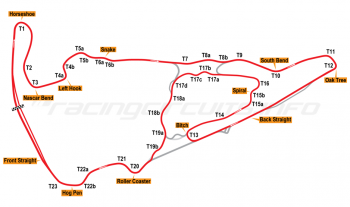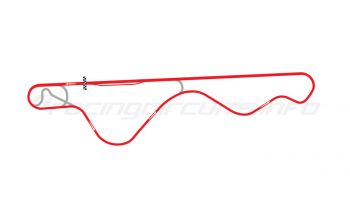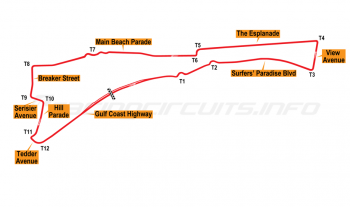Mugello
Circuit Overview
Mugello is one of Italy's classic circuits, tucked away in the rolling hills of the Tuscany region and beloved of the motorcycle racing brigade. Each year thousands pack into the grandstands to worship the MotoGP riders, in particular home hero Valentino Rossi, whose fans turn the hillsides yellow in deference to their hero.
Originally it was car racing that held sway, first with World Sportscars and then with Formula Two among the seasonal visitors and as late as 2000 it was an occasional addition to the Formula 3000 calendar. However, it was the permanent moving of the motorcycle Grand Prix in the 1990s that cemented Mugello's international presence and seemed to leave it as a hidden gem to the four wheeled circus, save for the occasional testing that it's owner Ferrari undertook.
That all changed in 2020, when the coronavirus pandemic decimated the normal F1 calendar and saw Mugello added as an extra round to great acclaim. While that event might have proved a one-off, it nevertheless opened many more eyes to the splendours of the Tuscan circuit.
Circuit History
Despite its classic course feel, Mugello is a relatively modern affair and actually the second circuit to bear this name. The original was a course along public roads, winding along 38 miles of Tuscan countryside. This saw action from 1914 through to 1970. Names such Giuseppe Campari, Enzo Ferrari and local idol Emilio Materassi were among the luminaries who raced the old Circuito del Mugello, which went from Scarperia uphill to Firenzuola, then through the Futa Pass and downhill to San Piero and Scarperia.
The advent of Mille Miglia dimmed Mugello's importance, but in the mid 1960s with the end of the round-Italy race, competitions on the Mugello roads resumed their position of significance once more. The Mugello GP was revived in 1955 and from the 1964 to 1969 as a Targa Florio-like road race consisting of eight laps of 66.2 km each. Road were closed for racing and qualifying, but during practice – incredibly – they remained open to the public.
The folly of this approach was exposed in 1970, when a seven month-old baby was killed when local racer Spartaco Dini crashed his Alfa Romeo GTA into a group of people at the village of Firenzuola during a private test. Four other people, including 2 young children, were seriously injured and that year's event proved the last. Authorities had already begun looking for a site for a permanent closed course and the tragedy only served to accelerate these plans.
The permanent circuit is born
Land at Barberino di Mugello was identified as being most suitable, nestling as it did in a valley to create natural sweeps and elevation changes. Several layouts were considered, before the final version was approved and construction began in 1973.
The new Mugello opened in June 1974 with a round of the F5000 series and was immediately popular with competitors. A long, sweeping main straight spilled into a rising right-hander, before rising and falling through the hillsides behind the pits through a series of fast corners. The World Sportscar Championship made several visits during the 1970s, while the original Formula Two series made it a mainstay of its schedule from the outset. The circuit was also very quickly adopted by the Motorcycle World Championships.
By the mid 1980s, however, Mugello was in financial trouble and there was much uncertainty as to the circuit's future. Persistent rumours abounded that the valley would be flooded to create a reservoir to supply nearby Firenze. However, in 1988, the circuit was purchased by Ferrari who intended to use it as an additional testing facility for its Formula One cars.
Ferrari renovates and motorbikes return
Extensive renovations were carried out in time for the 1991 season, including the construction of new pit and paddock facilities, the removal of Armco barrier in favour of concrete walls and the enlargement of many run-off and gravel areas. The rarely used short course was removed at this point, becoming instead an alternative shortcut lane towards the pits. Mugello had never looked better and the changes ensured the return of the Motorcycle World Championships and the debut of the World Superbikes. While the Superbikes moved elsewhere the Grand Prix stars remained, establishing Mugello as the permanent home of the Italian Grand Prix.
On four wheels, the circuit has hosted the FIA GT championships, Formula 3000 and the short-lived International Touring Car Championship. In 2012, it also held an official Formula One test session, while establishing itself as a popular national racing venue.
World first environmental credentials
Mugello has been acclaimed as the most sustainable racing circuit in the world in a review by Enovation Consulting and Right Hub in 2021. It scored the highest out of 96 circuits survey, aided by several ISO credentials, the EU Eco-Management and Audit Scheme (EMAS) and a 3 Star rating in the FIA’s Environmental Accreditation.
Since 2013, the circuit has hosted the K.i.S.S environmental and social sustainability programme, developed in conjunction with MotoGP and promoted by the FIM, Dorna and IRTA. The circuit uses 100% renewable energy and produces 25% of its annual energy demand on site using photovoltaic systems installed in the premises. To save on energy, the circuit uses LEDs on the external lighting systems. The circuit also has a rainwater recovery system which is used to operate toilets and for irrigation purposes. Approximately 120 water fountains are installed in public areas and additional drinking fountains are available to staff and racing personnel during the events, limiting use of plastics and plastic waste production.
Formula One makes an unexpected debut
The coronavirus pandemic of 2020 forced the cancellation of the Italian MotoGP event altogether, but there was an unexpected consolation, with confirmation that Mugello was set to play host to Formula One. The 'Pirelli Gran Premio Della Toscana Ferrari 1000' took place on September 13 on what was Ferrari's 1000th Formula One Grand Prix race, though it was not a great showpiece for the circuit's owners.
Despite fears that the high speed nature of the track might inhibit close racing, all of the events on the weekend calendar provided thrilling wheel-to-wheel action. The Formula One race featured two red-flag stoppages, after a pile-up triggered by bunching on a restart and a major accident for the Racing Point of Lance Stroll. Lewis Hamilton scored his 90th victory in a weekend of Mercedes-Benz domination (though at least the safety car, painted red for the occasion in nod to Ferrari's heritage, helped provide contrast to the all-black cars up front). After an uncompetitive race, the two Ferraris could only come home in eighth and 12th places.
As an idea of the ferocious turn of speed of modern Formula One cars, Lewis Hamilton set a new lap record of 1m18.833s, which is some 15 seconds faster than the best lap in the Formula 2 race and an enormous 28 seconds quicker than the fastest lap by MotoGP, set in 2021 by Johan Zarco on a Ducati Desmosedici GP21.
The real winner was Mugello itself, with many converts being found for the circuit among the four-wheeled racing fraternity. It is likely that the Tuscany GP will be a one-off, but it will certainly remain in the memories for a long time.
Jump onboard
Circuit info
- Mugello Circut, Via Senni 15, Scarperia, Firenze 50038, Italy
- +39 55 8499111
- Email the circuit
- Official website
Rate This Circuit
Votes: 6317
Plan a visit
Get your race tickets!
Brought to you with: 
We've teamed up with Motorsports Tickets to bring you the best deals for Formula One, MotoGP, Le Mans and more.












